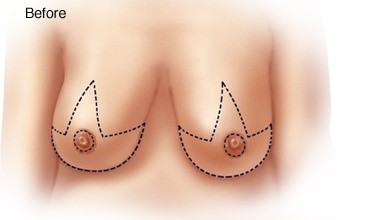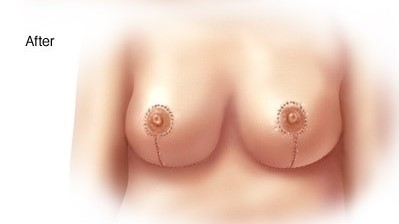Breast reduction surgery
Other terms: reduction mammaplasty
Breast reduction is a surgical procedure that reduces the volume and the weight of your breast if you have large breast. Skin, fat and glandular tissue are removed and breast is reshaped. Breast reduction surgery might also help improve your self-image and your ability to participate in physical activities.
Why it’s done?
When you have large breast, you might have one or more of the following symptoms:
- Chronic back, neck and shoulder pain that requires pain medications
- Chronic rash or skin irritation under the breasts
- Nerve bread
- Restricted activity
- Poor self-image related to large breasts
- Difficulty fitting into bras and clothing
You can have breast reduction surgery at any age — sometimes even as a teenager. But if your breasts aren’t yet fully developed, you might need a second surgery later in life.
You might postpone breast reduction surgery if you are planning to :
- Have kids: because the breast will increase in size during pregnancy, and you might have difficulty breastfeeding, although certain surgical techniques can help preserve your ability to breast-feed.
- Lose weight:Significant weight loss reduces breast size, but breast may sag at the same time.
Risks
General surgical risks:
- Anaesthesia side effects
- Bleeding
- Infection
Risks specific to breast reduction:
- Bruising, which is usually temporary
- Hypertrophic scars
- Removal of or loss of sensation in the nipples and skin surrounding the nipples (areolae)
- Difficulty or inability to breast-feed
- Differences in the size, shape and symmetry of the surgically altered left and right breasts, which might lead to further surgery to improve your appearance
- Fat necrosis that will give some hardness in some areas of the breast.
Before the surgery
Your plastic surgeon will likely:
- Evaluate your medical history and overall health
- Discuss your expectations for breast size and appearance after the surgery and placement of scars.
- Take photographs of your breasts for your medical record
Before breast reduction surgery, you surgeon might order :
- Complete various lab tests
- Get a baseline mammogram
- cessation of smoking for a certain period of time before and after surgery
- Avoid taking aspirin, anti-inflammatory drugs and herbal supplements, to control bleeding during surgery
How is it done?
Usually the day of the surgery or the day before your surgeon will draw a certain pattern on your breast that he will follow when removing the excess of skin and gland and reposition the nipple.
Generally, the scar will have an anchor type shape or sometimes called inverted T or less frequently a lollipop shape.


Results
Although you can see the change immediately, scars usually improve over time and final size and shape will settle after 3 months.
In case of loss of sensation, this can be permanent, but in most of the cases, sensation will come back within 12 months, In very large breast, sensation may be impaired before the surgery.